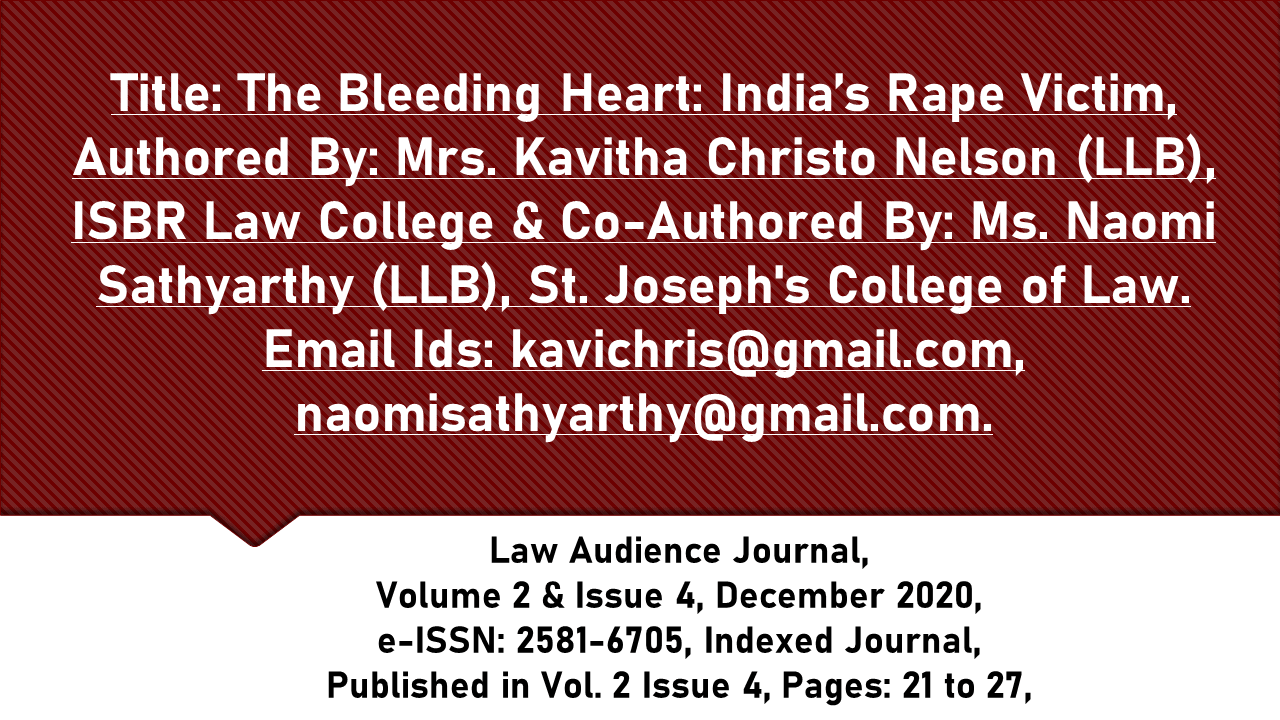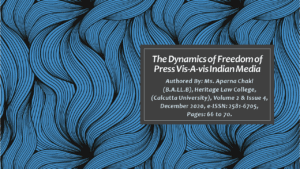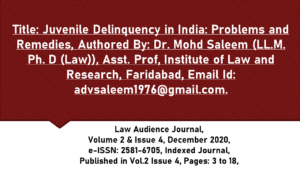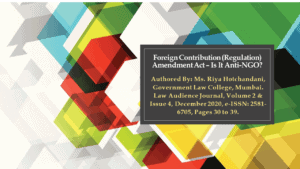Click here to download the full paper (PDF)
Authored By: Mrs. Kavitha Christo Nelson (LLB), ISBR Law College & Co-Authored By: Ms. Naomi Sathyarthy (LLB), St. Joseph’s College of Law.
Click here for Copyright Policy.
Click here for Disclaimer.
I. ABSTRACT:
“The bleeding heart: India’s Rape victim – after a mysterious force of evil men decimates the life of woman, young teens without even sparing Infants in India. The survivors of the traumatic experience either take an option of committing suicide or a very few come out to face with an entity embark on vicious assaults searching for hope and unveil the blindfolded justice”.
II. INTRODUCTION:
India is portrayed as goddess Bharath Matha or Mother India symbolizing a nation which honours and worships its women. The reality, however, paints a much darker picture according to the National Crime Records Bureau (NCRB) data one rape is committed every 16 minutes in some corner of India. The 2018 Annual poll by Thomson Reuters Foundation (London) named India as the most dangerous country for women due to the risk of sexual violence and harassment against women, the danger women face from cultural, tribal and traditional practices, and the country where women are most in danger of human trafficking including forced labour, sex slavery and domestic servitude. [[1]]
Ironically, in a country considered to be a land of goddesses, women live in constant fear for their safety. Though in the past few decades the status of women in India has progressed financially, economically and educationally, this progress has not translated into the safety of the women in the Country. Male chauvinism is still deeply engraved in the society, instilling a false sense of entitlement in men and resulting in sexual violence against women.
The Constitution of India envisages fundamental rights to women at equal par with men, in reality, goes anonymous. Victims of sexual Crimes are deprived of their fundamental ‘Right to Equality’ and ‘Right to life and personal liberty’ due to these heinous crimes. To women of this nation ‘Equal rights’ and ‘Equal treatment’ still remain a distant dream.
III. RAPE A HEINOUS CRIME:
“Rape is not merely a physical assault – it is often destructive of the whole personality of the victim. A murderer destroys the physical body of his victim, a rapist degrades the very soul of the helpless female.” – Dr. A.S. Anand. J[[2]] Rape inflicts upon its surviving victim and eternal trauma and anguish. The survivors of rape suffer from physiological and psychological trauma. They become emotionally stunted and suffer to form intimate bonds and often isolate themselves due to social stigma. Surviving rape is merely the start of an everlasting nightmare.
IV. SOCIAL STIGMA: THE BLAME GAME:
“Rape is thus not only a crime against the person of a woman (victim), it is a crime against the entire society. It destroys the entire psychology of a woman and pushes her into deep emotional crises. It is only by her sheer will power that she rehabilitates herself in the society which, on coming to know of the rape, looks down upon her in derision and contempt.”[[3]]
Usually, when a crime is committed it is the perpetrator of the crime who is tried. Whereas, in a case of Rape, the victim undergoes trial by the society. Victims are scrutinized for the outfits that they wear, the timing at which they remain outdoors and are often labelled as women of an easy character. The social stigma attached to rape victims is so devastating that women refrain from reporting rape.
Even those victims who dare to approach the authorities are often discouraged from taking legal action in the name of ‘family honour’ and are threatened with the possibility of the long legal battle that they must endure in order to get justice. The numerous legal reforms would not help these victims until the social stigma is removed and the procedural complications are reduced to a great extent.
V. WHEN PROTECTORS TURN PREDATORS:
-
The Mathura Rape Case:[[4]]
The infamous case brought about the first significant reform in the legal system with regard to sexual offences. A young girl of 14-16 years of age was raped by police officers on duty in the premises of the police station. The judiciary failed this young victim by returning a judgement of ‘NOT GUILTY’. The judgement was purely based on the assumption that the young girl was not a virgin and therefore she must have incited the officers to engage in sexual intercourse. To add insult to injury the court made the observation that the absence of visible marks on her body was proof of consensual sex.
The judgement incited widespread public outrage and resulted in The Criminal Law Amendment Act 1983 (No. 43). Section 360A- 360D were inserted to The Indian Penal Code, 1960 making custodial rape an offence punishable with rigorous imprisonment of seven years to life. The amendment shifted the burden of proof from the victim to the offender. Section 114A was inserted in The Evidence Act, 1872 making presumption as to absence of consent in prosecutions for rape case.
VI. JUDICIAL ACTIVISM: THE SAVING GRACE:
The Courts as protectors of Fundamental Rights through various landmark judgements, have brought about many progressive reforms in dealing with cases of rape and sexual assault.
-
Vishaka v. State of Rajasthan:[[5]]
A writ petition was filed to enforce the fundamental rights of working women under Article 14, 19 and 21 after the brutal rape of a social worker in State of Rajasthan attempting to prevent solemnization of Child Marriage. The petitioners sought to prevent sexual harassment at workplace through judicial process as no legislation existed to deal with the issue. The SC held that, “incidents of sexual harassment at workplace is a violation of the fundamental rights of ‘Gender Equality’ and the ‘Right to Life and Liberty’. It is a clear violation of the rights under Articles 14 15 and 21 of the Constitution”. The court laid down clear guidelines to prevent sexual harassment at workplace. These guidelines were implemented by enacting the “The Sexual Harassment of Women at Workplace (Prevention, Prohibition and Redressal) Act 2013”.
- State of Punjab v. Gurmit Singh & Ors.[[6]]
In the case of abduction and rape of a minor girl the court laid down that:
- As far as possible the Court must avoid disclosing the name of the victim
- In order for a victim to comfortably testify the trial must be conducted in camera
- The Court must effectively control the recording of evidence in the. While every latitude should be given to the accused to test the veracity of the prosecutrix and the credibility of her version through cross-examination, the court must also ensure that cross-examination is not made a means of harassment or causing humiliation to the victim of crime.
-
In Sakshi v. Union of India:[[7]]
In a writ petition filed seeking the issue of a writ in the nature of a declaration or any other appropriate writ or direction declaring inter alia that “sexual intercourse” as contained in section 375 of the Indian Penal Code shall include all forms of penetration such as penile/vaginal penetration, penile/oral penetration, penile/anal penetration finger/vaginal and finger/anal penetration and object/vaginal penetration;
Disposing the case, the Court laid down the following guideline in holding trial of child sex abuse or rape:
(i) a screen or some such arrangements may be made where the victim or witnesses (who may be equally vulnerable like the victim) do not see the body or face of the accused;
(ii) the questions put in cross-examination on behalf of the accused, in so far as they relate directly to the incident, should be given in writing to the President Officer of the Court who may put them to the victim or witnesses in a language which is clear and is not embarrassing;
(iii) the victim of child abuse or rape, while giving testimony in court, should be allowed sufficient breaks as and when required.
-
The Protection of Children from Sexual Offences Act (POCSO):
The guidelines provided in Sakshi v. UOI are implemented in the POCSO Act, 2005. The POCSO Act is a comprehensive Act intended to protect children against sexual crimes. The Act protects the interest of the child at every stage of the judicial process by incorporating child-friendly mechanisms for reporting, recording of evidence, investigation and speedy trial of offences through designated Special Courts. [[8]]
-
Nirbhaya Gang Rape: [[9]]
The case of rape and murder of a 23-year-old physiotherapy student on board in a moving bus by six men one of whom was a minor is the most gruesome case of rape that shocked the conscience of the people and the authorities. Due to widespread protest demanding justice for the victim a fast-track court was set up to hear the case. The Court sentenced all 4 accused to death by hanging, however the minor accused was tried by the Juvenile Justice Board and awarded the maximum sentence of 3 years.
On appeal The Supreme Court stating that the barbaric crime warranted capital punishment upheld the sentence of death. The request for pardon having been rejected by the President of India, the convicts were executed on 20 March,2020. The Nirbhaya Case directly resulted in the “The Criminal Law (Amendment) Act, 2013 (Nirbhaya Act)”. The Act broadened the scope of Section 375 of The Indian Penal Code, 1960. Section 375A was inserted into the IPC, which prescribes rigorous imprisonment for a term not less than 20 years to life, if the victim suffers injury. The age of consent has been increased to 18 years. The Juvenile Justice Act was amended to allow minors between the age group 16-18 to be tried as adults if they have committed heinous crimes. Discretion is vested with the Juvenile Justice Board to ascertain if the minor must be tried as an adult.
VII. CURRENT SCENARIO:
In Spite of the many amendments to criminal laws, the cases of sexual offence have only increased in the Country. According to the 2019 annual report of the National Crime Records Bureau (NCRB), 32033 rape cases were registered across the country, or an average of 88 cases daily, of these, 30,165 rapes were committed by perpetrators known to the victim (94.2 % of cases). Lack of proper implementation and other flaws in the system have turned these laws into toothless beast.[[10]]
Unnao rape case and Hathras rape case are clear indications of a flawed legal system. Even after Nirbhaya and the numerous amendments, the daughter of India still face sexual violence in their home, their workplace and on the streets. The Law of the land with respect to sexual offences needs to become more stringent. Perhaps, it is about time that we consider capital punishment for rape even in cases were the victim survives to serve as a deterrent to prevent future incidents of rape.[[11]]
According to the recent judgement of Karnataka HC in Criminal appeal No.266/2014 dated 21/10/2020 recommended death penalty for cases of gang rape: “it is appropriate for the Legislature/Central Government in order to curb the menace of ‘gang rape’ against woman, the provisions of Section 376D of Indian Penal Code requires further amendment imposing punishment for death in addition to the existing provision of imprisonment for life and shall also liable to fine on par with the provisions of Sections 376AB and 376DB of Indian Penal Code keeping in view the definition of ‘Woman’ under Section 10 of Indian Penal Code .”
VIII. CONCLUSION:
The increasing number of sexual offences is a cause for grave concern. Even more concerning is that the perpetrators of these crimes receive mild punishment or go unpunished. It is about time the Criminal law is made stricter to ensure that the perpetrators receive punishment that is proportionate to the pain and suffering that they inflicted upon the victims.
Do We Need Another “Rape Victim” To Amend Our Law?…
[[1]] Thomson Reuters Foundation (2018). THE WORLD’S 10 MOST DANGEROUS COUNTRIES FOR WOMEN [Data Set]. Retrieved from: https://poll2018.trust.org/.
[[2]] State of Punjab vs. Gurmit Singh and Ors. (16.01.1996 – SC): MANU/SC/0366/1996.
[[3]] Bodhisattwa Gautam vs. Subhra Chakraborty (15.12.1995 – SC): MANU/SC/0245/1996.
[[4]] Tuka Ram And Anr vs State of Maharashtra (1974) S.C. (Cri.) 580: AIR 185 (SC 1947).
[[5]] Vishaka and Ors. vs. State of Rajasthan and Ors. (13.08.1997 – SC): MANU/SC/0786/1997.
[[6]] State of Punjab vs. Gurmit Singh and Ors. (19.09.1996 – SC): MANU/SC/0138/1997: AIR 1393 (SC. 1996).
[[7]] Sakshi Vs Union of India Sakshi and Ors. vs. Union of India (UOI) and Ors. (26.05.2004 – SC): MANU/SC/0523/2004: AIR 566 (SC. 2004).
[[8]] MINISTRY OF WOMEN AND CHILD DEVELOPMENT, Model Guidelines under Section 39 of The Protection of Children from Sexual Offences Act, 2012, available at: https://wcd.nic.in/sites/default/files/POCSO-ModelGuidelines.pdf.
[[9]] The 2012 Delhi Gang Rape and Murder, https://en.wikipedia.org/wiki/2012_Delhi_gang_rape_and_murder.
[[10]] By Karthik K K, Crimes Against women spike during lock down, https://www.newindianexpress.com/states/karnataka/2020/jul/02/crimes-against-women-spike-during-lockdown-2164100.html.
[[11]] India Coronavirus: 14-year-old sexually assaulted at Delhi COVID-19 centre, https://www.bbc.com/news/world-asia-india-53522998.



